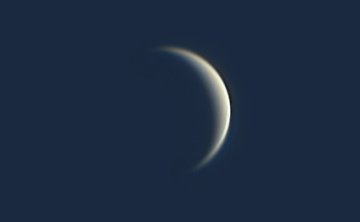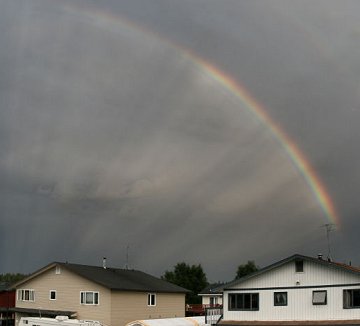 Where's Saturn? Is that a UFO--or the ISS? What's the name of that star? Get the answers from mySKY--a fun new astronomy helper from Meade. Where's Saturn? Is that a UFO--or the ISS? What's the name of that star? Get the answers from mySKY--a fun new astronomy helper from Meade. AURORA WATCH: A solar wind stream is heading toward Earth and it could spark a mild geomagnetic storm when it arrives late on July 26th. Unfortunately, auroras may be difficult to see because of interference from the nearly-full Moon. VANISHING VENUS: If you want to see a crescent-shaped planet, look soon, because Venus is about to vanish. "Venus' crescent is shrinking rapidly," reports Will Gater of South Devon, UK, who used an 8-inch LX200 to take this picture on July 24th: 
Gater's photo shows a 15% crescent. A week from today, it will be 10%. Two weeks from today, 4%. The reason for the rapid change is geometry: Venus is about to pass between Earth and the Sun. As the Earth-Venus-Sun line straightens, more and more of Venus' night side is turned toward us. By mid-August, Venus will be almost completely dark--or "New" like a New Moon Meanwhile, the crescent narrows. Venus is easy to find at sunset, hanging low and bright in the darkening western sky. Set up your telescope and take a look: sky map. RAINBOW SPOKES: Last week in Fairbanks, Alaska, a thunderstorm was approaching the house of photographer Patrick Cobb. "Just then," he says, "a hole opened in the clouds." Sunlight streamed through and made this unusual rainbow, with spokes: 
Photo details: Canon 30D, 24mm lens, f8.0, 1/100 sec
What are the spokes? Atmospheric optics expert Les Cowley explains: "The sun shining through holes in clouds makes shafts of parallel light, but they don't look parallel because perspective makes the rays appear to converge towards the point opposite the sun. The dark spokes are where converging shadows fall across rainbow-forming raindrops." "When you see rainbow spokes, pause and watch carefully," he adds. "As the clouds scud across the sky, moving sunbeams make the rainbow wheel rotate." Video, anyone?
.2007 Noctilucent Cloud Gallery
[Night-Sky Cameras] ["Noctilucent Cloud"--the song] | 
